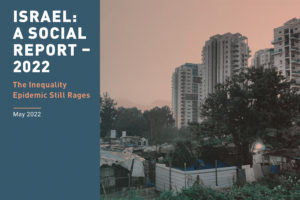Forty-five years into Israel’s domination of the Palestinian territories occupied in 1967, the Adva Center published its bi-annual report on the burden of the Israeli-Palestinian conflict, written by Dr. Shlomo Swirski. The report examines the economic, social, political and diplomatic burden of the conflict for Israel.
While Israel’s heads of state appear to be of the opinion that there is no connection between the performance of the Israeli economy and the Israeli-Palestinian conflict, some of the most prominent leaders of Israel’s economic institutions hold a different opinion. Professor Stanley Fischer, governor of the Bank of Israel, believes that under a peaceful solution the Israeli economy would exhibit much higher economic growth. Profession Zvi Eckstein, past deputy governor of the Bank of Israel agrees. Professor Manual Trajtenberg contends that unless Israel solves the Palestinian conflict, there will not be any significant changes in the areas of housing, education and culture.
Following are some of the major points made in the report:
1. The Israeli economy is subject to double jeopardy: Israel needs to deal not only with crises stemming from global developments but also with those caused by the conflict. As a result, during the last decade (2001-2011), Israel’s economic growth per capita grew more slowly than that of the countries of East Asia and Eastern Europe, and at a rate similar to that of Western countries. The problem is that in order to reach parity with Western countries, Israel needs to grow at a rate similar to those of the emerging economies of Asia and Eastern Europe.
2. Due to the potential for instability, Israel’s credit rating is low in comparison with the countries it would like to emulate.
3. Hostilities cost money: between 1989 and 2011, the Ministry of Defense received budget increments totaling NIS 48 billion (2010 prices) earmarked for the conflict with the Palestinians.
4. Budgets go for guns, not butter: During most of the past decade, the per capita budget for defense grew more (and was cut less) than the per capita budget for social services.
5. The social protest of the summer of 2011 did not change Israel’s priorities: The Trajtenberg Committee recommended instituting free education from the age of three, to be financed by a NIS 2.5 billion cut in the defense budget. However, the defense budget was not reduced but rather increased, and the funding is now slated to come from across-the-board budget cuts in the social service ministries.
6. Social services in the settlements are more generously funded than those in Israel proper: In 2009, central government subsidies for social services in the settlements averaged NIS 2,264 per capita, compared with NIS 1,859 per capita in Arab localities and NIS 1,719 per capita in Jewish development towns.






